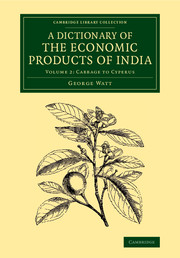
-
Select format
-
- Publisher:
- Cambridge University Press
- Publication date:
- October 2014
- January 2014
- ISBN:
- 9781107239159
- 9781108068741
- Dimensions:
- Weight & Pages:
- Dimensions:
- (244 x 170 mm)
- Weight & Pages:
- 1.09kg, 696 Pages
You may already have access via personal or institutional login
Book description
A Scottish doctor and botanist, George Watt (1851–1930) had studied the flora of India for more than a decade before he took on the task of compiling this monumental work. Assisted by numerous contributors, he set about organising vast amounts of information on India's commercial plants and produce, including scientific and vernacular names, properties, domestic and medical uses, trade statistics, and published sources. Watt hoped that the dictionary, 'though not a strictly scientific publication', would be found 'sufficiently accurate in its scientific details for all practical and commercial purposes'. First published in six volumes between 1889 and 1893, with an index volume completed in 1896, the whole work is now reissued in nine separate parts. Volume 2 (1889) contains entries from cabbage (introduced to India by Europeans) to Cyperus (a genus of grass-like flowering plants).
Contents
Metrics
Full text views
Full text views help Loading metrics...
Loading metrics...
* Views captured on Cambridge Core between #date#. This data will be updated every 24 hours.
Usage data cannot currently be displayed.
Accessibility standard: Unknown
Why this information is here
This section outlines the accessibility features of this content - including support for screen readers, full keyboard navigation and high-contrast display options. This may not be relevant for you.
Accessibility Information
Accessibility compliance for the PDF of this book is currently unknown and may be updated in the future.

